
Guests
- Colin Goddardsurvivor of the 2007 Virginia Tech massacre. He works with the Brady Campaign to Prevent Gun Violence.
On the eve of the first presidential debate, President Obama and Republican challenger Mitt Romney are being urged to address the problem of gun violence. Wednesday’s debate is taking place less than 10 miles from the site of the Columbine school shooting and 15 miles from the Aurora theater where 12 people were killed in July. At the site of the 2007 massacre that left 32 people dead at Virginia Tech, we’re joined by Colin Goddard, who survived the attack with four gunshot wounds. Goddard recounts his survival of the massacre and his backing of a campaign with fellow victims for presidential candidates to address gun violence. “The first presidential debate of this election is happening literally miles from both Columbine High School and Aurora, Colorado — two of the worst shootings in our country’s history,” Goddard says. “This is a debate about domestic policy. If there ever is a time to pose a question about gun policy in America to our candidates for president of this country, then this debate that’s happening on Wednesday is the time to do it.” [includes rush transcript]
Transcript
AMY GOODMAN: We’re on the road on a 100-city tour. On the eve of the first presidential debate, President Obama and Republican challenger Mitt Romney are being urged to address the problem of gun violence. Wednesday’s debate is taking place less than 10 miles from the site of the Columbine school shooting and 15 miles from the Aurora theater where 12 people were killed in July.
A new bipartisan ad created by survivors of recent massacres and the group Mayors Against Illegal Guns is set to air nationally on Wednesday. The ad is called “Demand a Plan” and features Stephen Barton, who survived the Aurora mass shooting.
STEPHEN BARTON: In a movie theater in Colorado, I was shot, shot in the face and neck. But I was lucky. In the next four years, 48,000 Americans won’t be so lucky, because they’ll be murdered with guns in the next president’s term, enough to fill over 200 theaters. So when you watch the presidential debates, ask yourself, who has a plan to stop gun violence? Let’s demand a plan.
UNITED AGAINST ILLEGAL GUNS SUPPORT FUND AD: United Against Illegal Guns Support Fund is responsible for the content of this advertising.
AMY GOODMAN: Early this morning, I came back from Blacksburg, Virginia, from Virginia Tech, and spoke with a survivor of another massacre. His name is Colin Goddard. He was shot four times during the 2007 Virginia Tech massacre that left 32 people dead. He now works for the Brady Campaign to Prevent Gun Violence. He was later featured in a documentary called Living for 32. As we walked through the Virginia Tech campus, I began by asking Colin Goddard to describe just what happened on that day of the massacre, April 16, 2007.
COLIN GODDARD: We’re right here behind Norris Hall, where the shooting happened. I mean, this is where I used to walk to class from parking my car every day. So, it’s been a while since I’ve been back here, but looks the same.
AMY GOODMAN: What class were you taking?
COLIN GODDARD: I was taking intermediate French, had classes here Monday, Wednesday, Friday, and was—you know, I picked up another classmate of mine that Monday morning, and we drove, parked off campus right over there and, you know, debated on skipping, actually, but instead, we took this walk and went through this door right here.
AMY GOODMAN: Let’s go in.
COLIN GODDARD: So, in here in the middle of Norris Hall, this is the hallway that resembled the hallway back in 2007. You can see, with the same kind of cinder block walls, white walls and white tile floor. And the hall where the shooting happened is now much different. I mean, it’s—now it’s wood panel floor. I mean, it’s got a much nicer look to it, in my opinion, and it really changed the look of the whole place. So, when I come back here now, you know, it doesn’t remind me exactly of what happened, but—and I still remember this hallway, but it looks much different now. And I know where I am, you know?
Actually, they put the numbers back on the rooms, which are not exactly the same numbers as numbers in each room of the shooting, but they’re close, like my room, 211, was probably right around here somewhere. And I was told that there was never going to be numbers associated with these rooms, so I was kind of shocked to learn last year when they put numbers back on.
AMY GOODMAN: So, tell us what happened here. What time did you get to school?
COLIN GODDARD: So I got to school probably a little late, 9:05, got into class here probably closer to 9:10. You know, teacher just kind of rolled her eyes as usual: Colin’s come in late. And, you know, classes was normal. I think we were, you know, conjugating French verbs, passé composé, imparfait. And then another student came in late, this girl Rachael, who was like the best student in our class, you know, always in the front. You know, it was very shocking that she came halfway through class. And so, we all looked at her and turned around and said, “Rachael, what gives? Why did you even come today? Class is almost over.” And she turned around, and she faced us, and—I’ll never forget—she said, “There was a shooting in my dormitory this morning, and they wouldn’t let anybody leave. They had the whole place on lockdown. I kept telling them I had class to get to, but they wouldn’t let me go, until finally they said, ’You’re free to go,’ and so I came right here.” And that’s when we all looked at each other like, “What? There was a shooting on campus?” Like, why hadn’t we heard about this before? I mean, you know, she said this happened hours before, and, you know, just 30 minutes ago I was off campus. But we thought, “Well, OK, you know, they let Rachael go, things must be under control,” and didn’t think much else of it.
And then, you know, probably about five minutes after Rachael coming in, when things were just normal, we heard this loud like bang, bang, bang! And this was coming from, you know, down the hall, behind closed doors. We honestly thought that it actually was coming from outside. They were working on that building right across that whole semester, so we heard all sorts of strange noises, and we chalked it up to more construction noise. The teacher resumed, and seconds later we heard a much louder bang, bang, bang! You could tell this was something, you know, in this hallway, this was not something outside. And the moment we heard those second bangs, I mean, the teacher’s expression just dropped. You could tell she was very concerned with what that was. We still didn’t—I still didn’t even know what that was. You know, it was kind of a shocked disbelief. You know, is that really a gun? So she went immediately to the doorway to look to see what was making all the noise. And as soon as she opened the door, she slammed it back shut, and she turned around to all of us and told all of us to get underneath our desks. And she asked somebody to call 911.
And for the first time in my life—I don’t know, you know, how or why I did—I pulled out my phone, and I dialed 911. And I heard the woman on the dispatch, and I said, “Look, I think there’s someone shooting a gun here in Norris Hall. I don’t know exactly what’s going on.” And the woman said, “Norris Hall?” I said, “Yeah, Norris Hall, Blacksburg.” She says, “Blacksburg?” I said, “Blacksburg, Virginia, America.” And she realized that my Nextel phone had contacted Nextel emergency somewhere in Ohio, so the woman had no idea where I was. Finally, I gave the location; she transferred me to Blacksburg police. I stated, you know, where I was again. “I think there’s someone shooting a gun in Norris Hall,” when at that moment we had bullets come through our classroom door.
And at that point, everyone just jumped to the ground. I mean, there was only one door to our room. I remember looking at the windows, thinking of going to the windows across the room, but in retrospect, I probably wouldn’t be here now if I had done that. I jumped under the desk next to me. I tried to turn it over and cover myself. I really only had seconds, and it was in total shock. You know, I was just conjugating French verbs, and now someone’s shooting me. And it came full circle. I really understood the situation that I was in once I heard—I felt one of those gunshots above my knee. I felt like someone had kicked me with all their might, and that kick sensation kind of faded into this sharp stinging, burning sensation that kind of faded into this warm warmness, warm wetness, that then kind of faded into numbness. And I remained pretty much numb from head to toe the entire nine-and-a-half minutes—and probably the longest nine-and-a-half minutes of my life.
At the end of it all, there were 17 people in my classroom, including my teacher. And I’m one of seven people who are still alive. The gunshots that we had heard were other classrooms down this hallway that he had visited. And, you know, this is all things that I’ve learned after the fact, that the police gave me a walkthrough a month later and told me many things that I—you know, I could remember being very alert, very conscious; I couldn’t remember the entire ordeal, and was able to piece a lot of it together through their information.
But when they pulled me out of this room, ultimately, they laid me somewhere here in the hallway for a while. The girl I had driven to class that day, Kristina, was lying with me. I remember she looked like she was about to fall asleep. So I kept trying to talk to her, keep her awake. You know, I knew that I was going to be OK when the police were there. I remember looking at the SWAT team members’ eyes, and they were—they looked like, you know, full moons, they were so big. They were so on edge, so alert. And they asked me if I could get up and leave, and I said, “There’s no way I can get up.” I didn’t know that I had a broken leg at that point. One of the bullets had broken my leg. I had received four shots in total at that time. And—
AMY GOODMAN: Where?
COLIN GODDARD: Above my—above my knee, in both of my hips, and then through my shoulder. This is the only one that ever exited. I still have three bullets here in small pieces, all over my hips and my knee. But once they realized I wasn’t going to get up, they put a cop on each leg and a cop on each arm and had to pick me up and walked me all the way down the hallway, down the flight of stairs and out through the front door, and laid me on the grass right outside and cut off my clothes, tried to figure out where I was bleeding, tried to stop the bleeding, and called an ambulance ultimately and threw me in it with another student who had been shot in the arm. And we took off to the hospital, that, by the time we were in route to the hospital, the closest hospital to our campus was already full of students and faculty, so we had to go to the hospital 30 minutes down the road. Oh, yeah.
AMY GOODMAN: How many students and teachers were in your class?
COLIN GODDARD: There was 16 students, and my teacher made 17. My teacher was killed, probably one of the first people in the class, and then nine other students were killed. So we, I think—my French class was the worst ratio of students shot and injured and killed. I don’t know—I don’t know why. I mean, you know, we did very little differently than other people in other classrooms. The seven of us who did survive were all located in the same corner of the classroom, the back right corner. I think there just must have been a lot of people and bags and desks in the way for him to not kind of, you know, methodically walk around us, as he did in other parts of the classroom and, as I learned, that he did in other rooms. I never heard him say a word, never heard anyone really talk. It was pretty quiet.
AMY GOODMAN: Did you see him clearly?
COLIN GODDARD: I saw—when I dove to the floor the first time, I looked towards the front of the classroom once and saw someone with military boots, with khaki pants, with a white shirt, and with two holsters over both shoulders. And at that point, I stopped looking, and I turned away. So I never saw the person, no. And when the police asked me to help identify who it could be, I couldn’t tell them the description. I just said I didn’t know. I didn’t—I realized who I was looking at at the time was the person, and that was enough for me.
AMY GOODMAN: And what happened to him?
COLIN GODDARD: Ultimately, after about nine-and-a-half minutes, once the police had entered our building, and you could tell they were very close—I remember hearing them move in the room above us. And the girl—a girl next to me, Emily, had actually retrieved the phone that I had called the police with, that I had just kind of thrown out of my hand, tried to act natural. And she had actually took that underneath her hair and remained on line with the police the entire time, and she told them, “He’s here. He’s in 211,” when they came right here. And moments before they came in, he shot himself in the head in the front of our classroom—that I didn’t know about until the police entered the room. And the first thing that they said was “Shooter down.” And that’s when I realized it was all over and I was going to be OK.
Yeah, looking at—me looking at this now, it’s different. I mean, now this is the Center for Peace Studies and Violence Prevention. I mean, I don’t think you could have turned something, you know, so bad into something so good, you know. And I think that’s what I try to do with my life, and what I’m doing now with the Brady Campaign is to take a negative experience and turn it toward something positive, so what happened here does not happen somewhere else.
AMY GOODMAN: Where is the Center for Peace Studies? Is it that one?
COLIN GODDARD: Yeah, this is it. It’s that wall right there. Yeah, the Global Technology Center is part of where they can hold international conference calls, and they have streaming TVs. But the actual peace center offices are just right over there. And the first director of the peace center was the late husband of my French teacher. He was another faculty member here on campus and started this whole peace center, which—you know, he does wonderful things, Dr. Jerzy Nowak. And, you know, for the man to come back to the same place where his wife was killed and work every day and try to find some good in it, you know, it’s—it’s powerful.
So, yeah, my room was 211. I don’t—yeah, they don’t go up that high. But it’s just—it was just in—they have named some of the other classrooms here after teachers who were killed.
AMY GOODMAN: So, here we’re walking past the Center for Peace Studies and Violence Prevention.
COLIN GODDARD: Yeah, that almost wasn’t to be. They almost destroyed this entire building and were going to put up a permanent landmark in its place. I think it was a good idea to keep the building here, because, you know, the face of our school hadn’t changed. You know, this building is still here. Now it’s onto something better. I also heard that there’s a lot of scientific equipment in the bottom basement was built here that really can’t be disassembled and replaced. So, I think kind of all of that together just made them decide to keep it as it is. But to renovate it and, like I said, and not to put it back to classroom use, but to turn it into a Center for Peace Studies is—I don’t really know what else you could do better than that, in my opinion.
AMY GOODMAN: So, Colin, since that time, you’ve learned a lot more, for example, about the shooter and how he came to be in this hallway and having killed so many, 32 altogether, that day.
COLIN GODDARD: Right. I think, you know, first, after the shooting, I was really upset, really angry with him, obviously, that why did he do something like this? And learning more about his past, I learned that this was someone who had been ridiculed and tormented throughout his entire time in school—grade school, high school—you know, that ultimately couldn’t connect with society, and ultimately, I think, had to go out showing society how much it hurt him, you know?
But, you know, he had warning signs that the school was aware of. He had been arrested for stalking girls on campus months before, and ultimately sent to a mental health facility, where he was evaluated by a judge and was adjudicated to be a danger to himself. And with that adjudication, under federal law, that prohibits you from buying a gun. But in Virginia in 2007, they only sent those records to our background check system if you’re then told to get inpatient therapy. Cho was told to get outpatient therapy, so his record never made it into the background check system. So, several months after that incident, instead of signing up for therapy, he went to the gun store down the road from campus and went over the internet and bought a Glock nine-millimeter and a Walther 22 and a couple hundred rounds, and then ultimately walked into this building a couple months after that and killed 32 people and himself.
AMY GOODMAN: Professor Giovanni, a few years before that, threatened to resign if he wasn’t removed from her class.
COLIN GODDARD: Yeah, I think his behavior was kind of alarming. I mean, not only should it raise the flag of several teachers directly, but to raise the flag of his peers, of other people who lived on this campus, other students, you know? I mean, why was he never dealt with appropriately? Why was he never given the help that he was so badly asking for, you know? You know, hindsight is 20-20 in retrospect, but, God, if you learn something from that, you’ve got to change it. You know, you can’t let this same situation happen somewhere else.
AMY GOODMAN: And now, Aurora massacre victims are coming to meet with you?
COLIN GODDARD: Yeah, and now it has happened somewhere else, this time in a movie theater in Colorado by another young person who obviously had problems and should never have had his hands on a gun in the first place. And as time develops, you know, from the shooting in Aurora, Colorado, we’ll learn more and more about this particular person and what the school knew about him, and probably we’ll find more people who said, yeah, you know, there were some warning signs, and he should never have had that gun that he had. And unfortunately, it takes horrible incidences in this country to get things changed, but, you know.
AMY GOODMAN: You’re leading a campaign for President Obama and Mitt Romney to be asked in the first presidential debate by the moderator Jim Lehrer—well, why don’t you tell us what you’re asking for?
COLIN GODDARD: The first presidential debate of this election is happening literally miles from both Columbine High School and Aurora, Colorado, two of the worst shootings in our country’s history. This is a debate about domestic policy. If there ever is a time to pose a question about gun policy in America to our candidates for president of this country, then this debate that’s happening on Wednesday is the time to do it. And we can’t afford to have a vague question asked about this that will get platitudes. We need a specific question asked about specific policies and specific ideas that both candidates have on how they will stop another 48,000 Americans who will be murdered with firearms during their next four years in office. I mean, if this is not a public health issue of utmost concern to our candidates, then they don’t have my vote.
AMY GOODMAN: Colin Goddard, shot four times during the 2007 Virginia Tech massacre that left 32 dead, he now works for the Brady Campaign to Prevent Gun Violence. Up next, Professor Nikki Giovanni from Virginia Tech. She taught the shooter. Stay with us. A 15-second break.

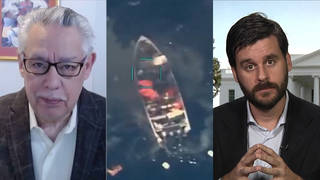
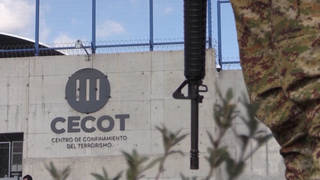
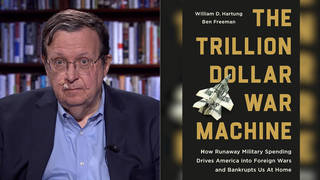
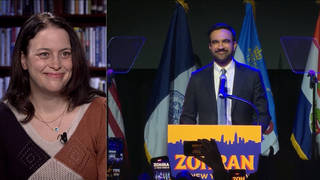





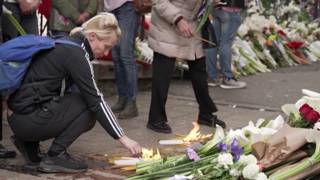
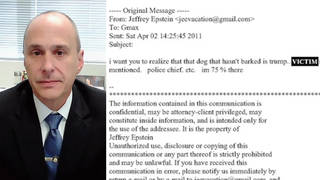
Media Options